| Article ID | Journal | Published Year | Pages | File Type |
|---|---|---|---|---|
| 1862320 | Physics Letters A | 2007 | 7 Pages |
Landau Fermi liquid theory predicts that the differential conductivity between metallic point and metal is a symmetric function of voltage bias V. This symmetry holds if the particle–hole symmetry is preserved. We show that the situation can be different when one of the two metals is a strongly correlated one whose electronic system can be represented by a heavy fermion liquid. When the heavy fermion liquid undergoes fermion condensation quantum phase transition, the particle–hole symmetry is violated making both the differential tunneling conductivity and dynamic conductance asymmetric as a function of applied voltage. This asymmetry can be observed when the strongly correlated metal is either normal or superconducting. We show that at small values of V the asymmetric part of the dynamic conductance is a linear function of V and inversely proportional to the maximum value of the gap and does not depend on temperature provided that metal is superconducting, when it becomes normal the asymmetric part diminishes at elevated temperatures.
